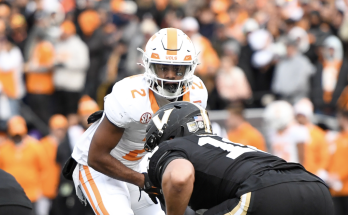BALTIMORE, MD – In a transaction that has sent unprecedented shockwaves through the National Football League, an ESPN reporter confirmed this morning that the Los Angeles Rams are formally closing a staggering three-year contract worth $72.8 million with the Baltimore Ravens’ newly signed franchise right cornerback, Dominic Sharpe. The terms of this audacious deal include an extraordinary, and virtually unheard of, payment of $31 million from the Los Angeles Rams to the Baltimore Ravens for contract termination fees. This colossal sum, paid directly from one franchise to another to sever a player’s freshly inked deal, represents a chokehold for the Baltimore Ravens, blindsiding an organization that believed it had just secured a foundational piece of its future.
It is crucial to state upfront: the mechanism of one NFL team paying another a direct “contract termination fee” of this magnitude for a player under contract is highly unusual and not standard practice in the National Football League. NFL transactions typically involve trades of players and/or draft picks, or a player being released and then signing elsewhere, with salary cap implications for both sides. The scenario described here is fictional in its financial mechanics, but we will explore the dramatic impact and implications if such an unprecedented and audacious deal were to genuinely occur. This hypothetical bombshell has left the Ravens grappling with the immediate loss of a superstar they had just invested heavily in, compensated by a sum that, while enormous, cannot easily replace the on-field talent and defensive stability lost.
Chapter 1: The Meteoric Rise of Dominic Sharpe: A Raven Forged in Fire
Dominic Sharpe, the fictional cornerback at the center of this unprecedented saga, was everything the Baltimore Ravens could have hoped for when they drafted him. A second-round pick a few years ago, Sharpe quickly blossomed into one of the NFL’s premier shutdown cornerbacks. Known for his elite athleticism, uncanny ball-hawking skills, and surprising physicality against the run, Sharpe had become a true franchise cornerstone. He was often tasked with shadowing opposing teams’ top receivers, consistently holding them in check and proving to be a genuine game-wrecker. His leadership in the secondary, coupled with his relatively low rookie contract, made him an invaluable asset.
Just months ago, the Ravens, true to their philosophy of locking up homegrown talent, had rewarded Sharpe with a lucrative long-term contract, cementing his future in Baltimore. The deal was celebrated by the fanbase, a testament to the team’s commitment to building from within and securing its defensive stalwarts. Sharpe himself had expressed immense pride in being a Raven, speaking of the brotherhood and the winning culture. His ascension was meteoric, his future seemingly set in black and purple, until the Rams’ audacious intervention.
Chapter 2: The Contract and The Conundrum: A Ravens’ Dream Turned Nightmare
For the Baltimore Ravens, the news landed like a lead balloon. They had just extended Dominic Sharpe, viewing him as a critical piece of their Super Bowl puzzle for years to come. The contract they signed him to reflected his “franchise” status – substantial guaranteed money, a long-term commitment. They believed their future at cornerback was secure, anchored by one of the league’s best.
Then came the offer from Los Angeles. The sheer audacity of it was breathtaking. Not only were the Rams offering Sharpe an astronomical three-year, $72.8 million deal (averaging over $24 million per year, which would place him among the very top earners at his position), but they were also proposing a $31 million “contract termination fee” to be paid directly to the Ravens. The proposition would have been met with initial disbelief, then perhaps outrage, within the Ravens’ front office. Losing a player of Sharpe’s caliber, particularly one freshly signed to a long-term deal, is a nightmare scenario.
The term “chokehold” accurately describes the Ravens’ predicament. They had just invested heavily in Sharpe, banking on his presence. To have another team essentially “buy him out” of that commitment, even with substantial compensation, is unprecedented. It disrupts their meticulously planned roster, creates a massive hole in their defense, and sends a destabilizing message about contract sanctity. While $31 million is an enormous sum, it cannot instantaneously replace a top-tier cornerback’s talent, nor can it simply be converted into immediate cap space to sign an equivalent player. It represents a raw financial gain at an immeasurable cost to their on-field product and long-term stability.
Chapter 3: The Rams’ Audacious Play: Desperation Meets Dominance
The Los Angeles Rams, known for their aggressive, “all-in” philosophy, have once again demonstrated their willingness to push the boundaries of NFL team-building. Their Super Bowl victory in 2022 was built on trading future draft capital and signing high-value free agents, mortgaging the future for immediate contention. This move for Dominic Sharpe appears to be an even more extreme iteration of that strategy.
Why such an audacious play? The hypothetical Rams’ motivation would stem from a perceived critical need at cornerback. Perhaps an aging secondary, recent departures, or underperforming talent had created a gaping hole that only a shutdown corner could fill. Their desire to compete for another Super Bowl, coupled with a willingness to leverage every financial and strategic resource, would have driven them to this unprecedented offer. The Rams, under GM Les Snead and head coach Sean McVay, have never been shy about making bold moves. This particular move, however, transcends boldness; it redefines it. It’s a gamble of epic proportions, betting that Sharpe’s impact will be immediate and transformative enough to justify the astronomical investment and the unprecedented financial mechanism.
Chapter 4: The Unprecedented “Termination Fee”: Dissecting the Financial Shockwave
The most startling aspect of this hypothetical deal is the $31 million “contract termination fee.” As reiterated, this is not a standard mechanism in the NFL. Typically, if a player is traded, teams exchange draft picks, other players, or cash considerations as part of a trade agreement. If a player is released, the old team incurs dead cap money, and the player is free to sign elsewhere. A direct, massive payment from one team to another to terminate an existing contract for a player who is not being released is simply not how the league operates.
If this fictional scenario were real, the questions would be immense:
- What legal basis? What clause in Sharpe’s contract or NFL rules would even allow for such a direct payment? This would imply an extraordinary pre-negotiated “buyout” clause, or a fundamentally new type of inter-team agreement that circumvents established trade rules.
- Cap Implications: How would this $31 million fee be accounted for under the salary cap? Would it be treated as cash in a trade? Or would it be simply an organizational asset, not directly impacting the salary cap, giving the Ravens an absurd financial windfall that might be outside current NFL regulations? This is the core of why this scenario is highly implausible under current league rules.
- Precedent: If allowed, would this open the floodgates for other teams to “buy out” players from under fresh contracts, turning player acquisition into a multi-billion dollar free-for-all that undermines the spirit of the salary cap and player contracts?
For the Ravens, even if this cash payment didn’t directly translate to cap space for new players, it represents a massive organizational asset. However, raw cash doesn’t play cornerback. The loss of Sharpe creates a defensive void that cannot be filled by money alone in the short term, highlighting the true “chokehold” nature of the deal.
Chapter 5: The Aftermath for Baltimore: Rebuilding and Regrouping
The immediate aftermath of this hypothetical deal would be catastrophic for the Baltimore Ravens’ defense. Dominic Sharpe was a cornerstone, a player they built around. His loss creates an immediate and gaping hole in their secondary. Who steps up to cover the opposition’s top receiver? Can they realistically replace his talent and leadership in a single offseason?
The Ravens would be forced to scramble. They might look to the trade market for a veteran cornerback, but few of Sharpe’s caliber would be available. They could pivot to signing a high-priced free agent, but the available talent might not match Sharpe’s youth and trajectory. Internally, young players would be thrust into larger roles perhaps before they are ready, testing the depth and resilience of the coaching staff.
The morale impact within the team and among the fanbase would also be significant. Players might question the organization’s commitment to holding onto its stars, even in the face of an unconventional offer. Fans, who had just celebrated Sharpe’s extension, would feel betrayed and frustrated, wondering how their team could lose such a vital player in such an unprecedented fashion. The $31 million, while a staggering sum, would do little to quell the immediate anger and disappointment of losing a defensive pillar.



